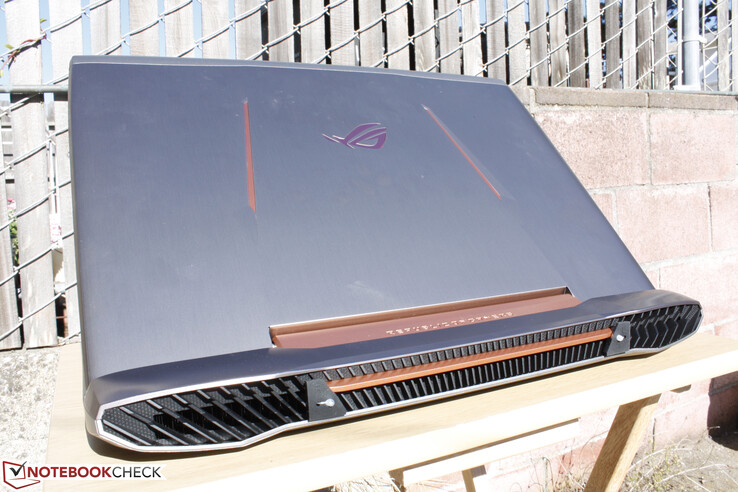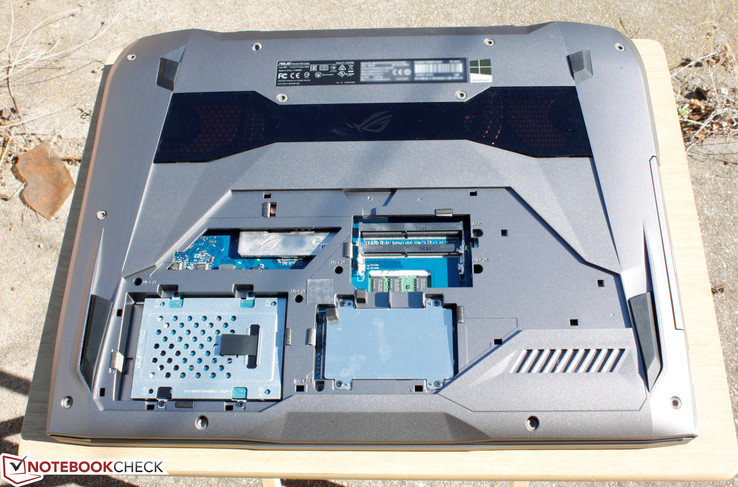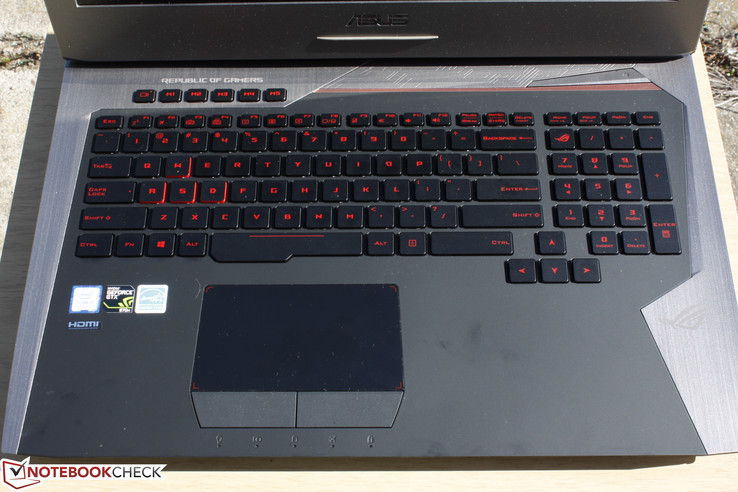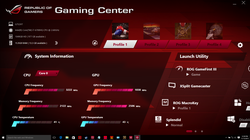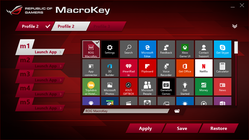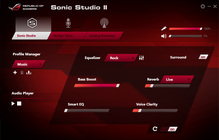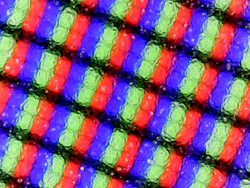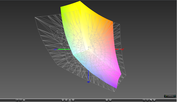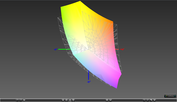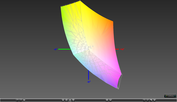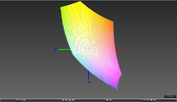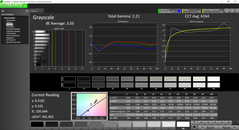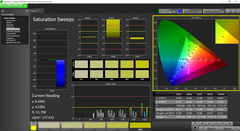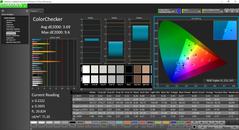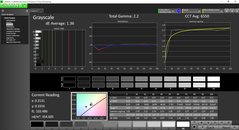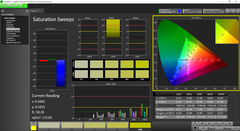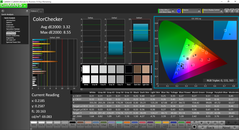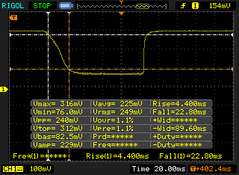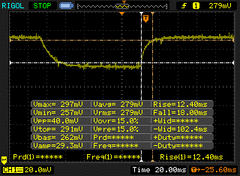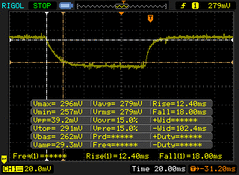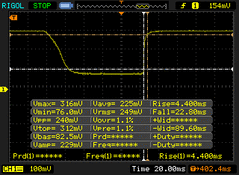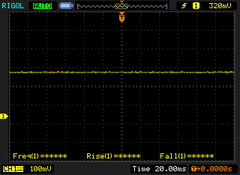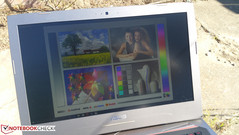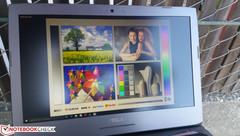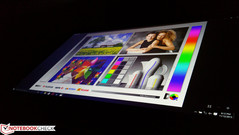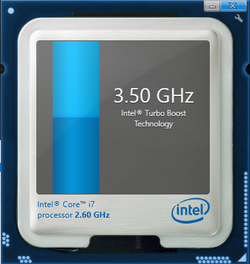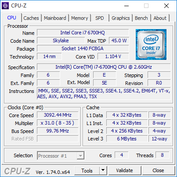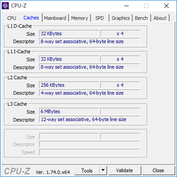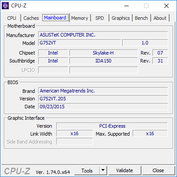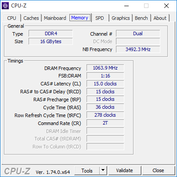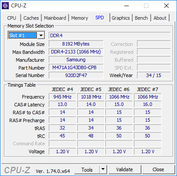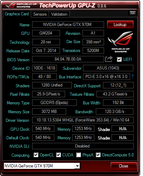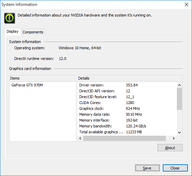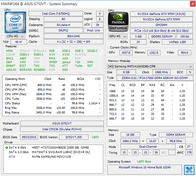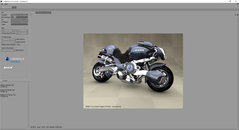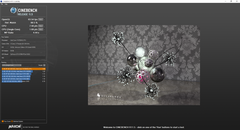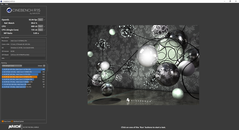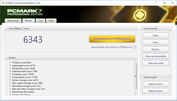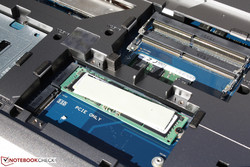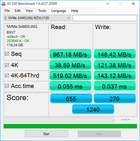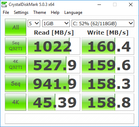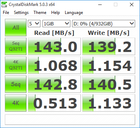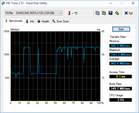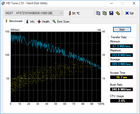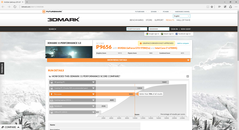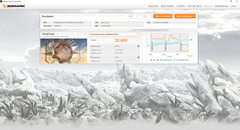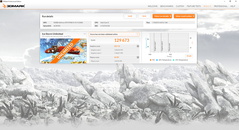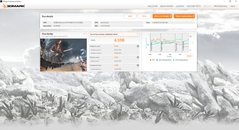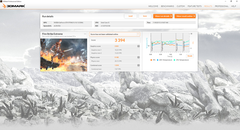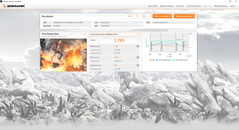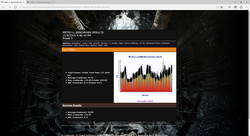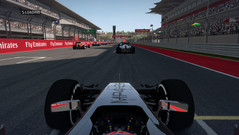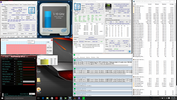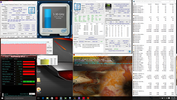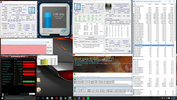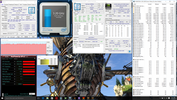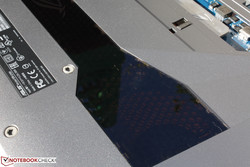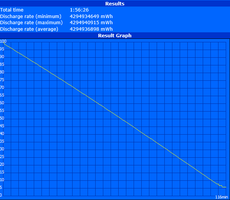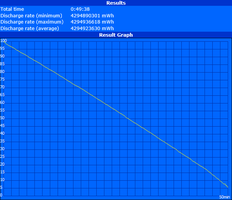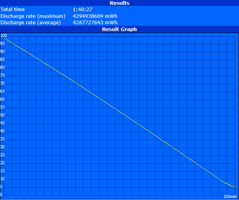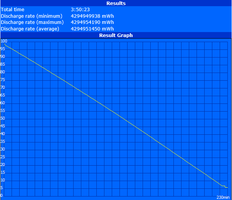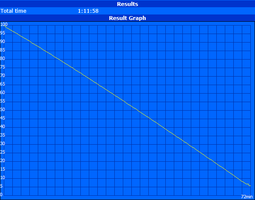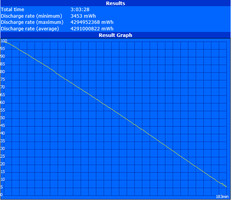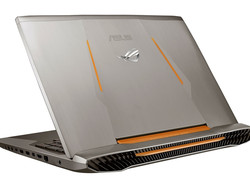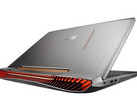Asus ROG G752VT Notebook Review
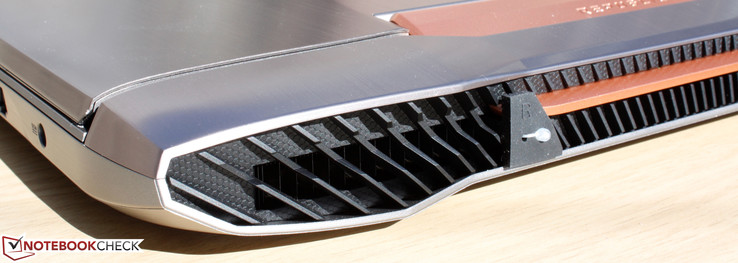
November 18, 2015 update: Asus has confirmed with us that vapor cooling is only available on the G752VY. The G752VT uses a standard cooling solution. The review has been updated to reflect this.
The G750 series can be seen as the poster child for the Republic of Gamers notebook lineup. The flagship notebooks have consistently been number near or at the top of our list of top 10 gaming notebooks. Thus, while the exotic GX700 will likely grab more headlines, it's the G752 that will actually make it onto more consumer hands.
The G752 brings about a complete redesign and boasts vapor chamber cooling to give it that marketing edge over competitors. However, vapor chamber cooling is only available on specific higher-end SKUs, so our G752VT is not equipped with the more efficient cooling system. We will have a full review on a SKU with vapor chamber when the unit becomes available.
The look is certainly flashier, but are the changes just hot air? We'll take a closer look at the G752VT SKU to find out if the hardware is really an upgrade from its predecessor.
Case
The G752 brings about major changes both inside and out. Gone is the matte black fighter jet-inspired color palette in favor of sharper accents, copper-colored brushed aluminum surfaces, and even hints of textured plastic along the front edge. The slightly rubberized palm rests and sharp exhaust vents have been carried over from the G751. The aluminum belly of the unit includes a transparent plastic window for users to glimpse into the cooling system of the notebook. Indeed, many of these changes are aesthetic in nature as Asus has gone for a brighter and more complicated design to attract more gamers.
Has build quality suffered as a result? The base is still rigid and extremely difficult to twist from the front edges. Nonetheless, the center of the keyboard and the surface area immediately above the optical drive can still be depressed with a moderate amount of force. The use of multiple sheets of materials (brushed aluminum surfaces, plastic, rubberized palm rests) instead of fewer and larges pieces like on the original G751 also means that the there can be unintentional gaps between where the materials meet. The front corners of the palm rests, for example, can be pushed down because of the gap between it and the plastic piece immediately underneath. It's a similar kind of manufacturing defect we observed on the Lenovo Y50, though to a lesser degree on the Asus.
The outer lid is moderately susceptible to both pressure down the center and side-to-side twisting, but not significantly enough to be of any concern. Its bar hinge is very taut to prevent heavy teetering of the lid. The maximum angle, however, is only up to 120 degrees. The notebook exhibits a bit of creaking when attempting to twist or depress its surfaces. Compared to the MSI GT72 or GT72S, the MSI design is less aggressive and a bit more solid. Perhaps disappointingly, the quality of the G752 has neither improved nor declined when compared to its immediate predecessor. It's a step sideways in favor of a new coat of paint.
What's for certain, however, is that the G752 is almost as heavy as the G751 with an even larger footprint than many of its 17.3-inch competitors including the Alienware 17 and Eurocom P7 Pro. At nearly 333 mm in depth, this is a very long notebook since the rear has been extended to accommodate the cooling system. The G752 is still noticeably thinner than its predecessor from 22.9 mm up front to 42.9 mm on the rear.
Connectivity
The G752 has retained all the physical ports of the G751 with one notable change. VGA has been dropped in favor of a USB 3.1 Gen. 2 Type-C port that also doubles as Thunderbolt 3. Competing models tend to offer features that the Asus is missing including two additional USB 3.0 ports on the GT72, two full-size DisplayPort ports on the Eurocom P7 Pro, and a Graphics Amplifier port on the Alienware 17 for external graphics support.
Also unlike the aforementioned models, the G752 continues to have no ports on the rear. This means that the right-hand side can become tangled or crowded with wires to create an unfavorable condition for right-handed users.
Communication
WLAN and Bluetooth 4.0 are provided by an Intel Dual Band (2x2) wireless-AC 7265 module capable of transfer rates of up to 867 Mbps. There appears to be no options for gaming-centric Killer wireless cards. WWAN or GPS options are not available.
Accessories
Included extras are a warranty card, cable tie, and Quick Start guide. It would have been nice to see a drivers disc or Windows installation disc as on notebooks from Eurocom, especially since the G752 includes an optical drive. A cleaning cloth would have been a nice addition as well. Branded optional accessories from mice to backpacks abound for ROG products.
Maintenance
A small hatch on the bottom of the unit can be easily removed with a Philips screwdriver to reveal the secondary HDD, M.2 SSDs, and 2x SODIMM slots.
Access to other core components like the CPU, GPU, WLAN card, battery, and the last two SODIMM slots has not been made user-friendly. There are at least 20 other screws to remove before the bottom cover can be removed. Even then, however, the panel is attached very tightly to the base where even a sharp edge won't do the trick. While unfortunate, this is almost expected as Asus ROG models are traditionally made difficult to access.
Asus has told us that both the CPU and GPU are non-upgradeable anyway, so tinkering with the hardware at this level won't get you very far.
Warranty
Standard coverage lasts for 12 months for orders worldwide. While this is half of what some other manufacturers tend to offer (Gigabyte offers 24 months standard), Asus throws in 12 months of accidental damage protection free-of-charge.
The manufacturer does not offer a No Dead Pixel policy and instead has a minimum number of pixel defects before the warranty applies.
Input Devices
Keyboard
A quick glance at the G752 will show that the layout of the keyboard is the same as its predecessor. Users are treated with 2.5 mm of key travel and rollover of up to 30 keys. Like on the G751, the keys are of high quality, do not wiggle in place, are quiet with little clatter, and with satisfactory feedback. It may not feel as solid as on the GT80, but it's very good for a Chiclet keyboard nonetheless.
New additions include two more macro keys on the top left for a total of five. Competing models from Alienware or Aorus tend to have their Macro keys arranged in a column instead, so this is down to user preference.
Touchpad
Like the keyboard above it, the large touchpad is again lifted directly from the G751 with no changes to texture or size. The trapezoidal surface area (~12 x 6.8 cm) provides a smooth and accurate glide with none of the minor issues we experienced on the G751. However, the cursor will sometimes become unresponsive if gliding from the corners of the touchpad towards the center. The Asus Smart Gesture provides accessible options and can recognize inputs of up to four fingers.
The dedicated mouse keys are again slightly rubberized and rough in texture. Travel and feedback are acceptable - Not as solid as on the MSI GT72, but with deeper travel than on a Eurocom. The auditory feedback is definitely quieter than both competitors as well.
Display
The 1080p panel is so far the only option available on the G752. G-Sync comes standard and a quick search for the LP173WF-SPF3 panel name shows that it appears on no other notebooks in our database. Subjectively, we can observe no screen-door effect or graininess to images. Very minor backlight bleeding can be observed near the bottom right corner that is only noticeable at high brightness and very dark ambient conditions.
Brightness and contrast remain nearly identical to its predecessor, so Asus has made no major improvements to the display itself. Colors and grayscale, however, are a bit more accurate this time around before any calibration attempts. Its contrast of nearly 1000:1 is roughly double that of the Gigabyte P37X. Images and video playback look fantastic on the Asus notebook.
| |||||||||||||||||||||||||
Brightness Distribution: 89 %
Center on Battery: 357.2 cd/m²
Contrast: 976:1 (Black: 0.366 cd/m²)
ΔE ColorChecker Calman: 3.69 | ∀{0.5-29.43 Ø4.77}
ΔE Greyscale Calman: 3.05 | ∀{0.09-98 Ø5}
84% sRGB (Argyll 1.6.3 3D)
55% AdobeRGB 1998 (Argyll 1.6.3 3D)
61.8% AdobeRGB 1998 (Argyll 3D)
84.5% sRGB (Argyll 3D)
66.3% Display P3 (Argyll 3D)
Gamma: 2.21
CCT: 6164 K
| Asus G752VT | Asus G751JY | Alienware 17 R2 | Eurocom P7 Pro | MSI GT72S 6QF | MSI GS70-6QE16H21 | Gigabyte P37X | |
|---|---|---|---|---|---|---|---|
| Display | -2% | 0% | 1% | 2% | 8% | 4% | |
| Display P3 Coverage (%) | 66.3 | 65.9 -1% | 66.6 0% | 67.2 1% | 67.6 2% | 67 1% | 68.7 4% |
| sRGB Coverage (%) | 84.5 | 83.1 -2% | 84.3 0% | 85.3 1% | 86.1 2% | 97.3 15% | 87.9 4% |
| AdobeRGB 1998 Coverage (%) | 61.8 | 60.8 -2% | 61.6 0% | 62.4 1% | 63 2% | 67.6 9% | 64 4% |
| Response Times | -24% | ||||||
| Response Time Grey 50% / Grey 80% * (ms) | 30.4 ? | 43 ? -41% | |||||
| Response Time Black / White * (ms) | 27.2 ? | 29 ? -7% | |||||
| PWM Frequency (Hz) | |||||||
| Screen | -4% | -5% | -12% | 6% | -2% | -10% | |
| Brightness middle (cd/m²) | 357.2 | 329 -8% | 331 -7% | 335.4 -6% | 356.7 0% | 172 -52% | 361.7 1% |
| Brightness (cd/m²) | 339 | 320 -6% | 307 -9% | 319 -6% | 326 -4% | 161 -53% | 347 2% |
| Brightness Distribution (%) | 89 | 92 3% | 84 -6% | 88 -1% | 85 -4% | 85 -4% | 91 2% |
| Black Level * (cd/m²) | 0.366 | 0.34 7% | 0.3 18% | 0.384 -5% | 0.282 23% | 0.26 29% | 0.734 -101% |
| Contrast (:1) | 976 | 968 -1% | 1103 13% | 873 -11% | 1265 30% | 662 -32% | 493 -49% |
| Colorchecker dE 2000 * | 3.69 | 4.13 -12% | 4.88 -32% | 5.14 -39% | 4.16 -13% | 2.06 44% | 2.81 24% |
| Greyscale dE 2000 * | 3.05 | 3.72 -22% | 3.63 -19% | 4.44 -46% | 2.47 19% | 2.42 21% | 1.92 37% |
| Gamma | 2.21 100% | 2.36 93% | 2.17 101% | 1.98 111% | 2.29 96% | 2.45 90% | 2.21 100% |
| CCT | 6164 105% | 6352 102% | 6325 103% | 6464 101% | 6860 95% | 6855 95% | 6384 102% |
| Color Space (Percent of AdobeRGB 1998) (%) | 55 | 55 0% | 55 0% | 56.1 2% | 56 2% | 62 13% | 57.95 5% |
| Color Space (Percent of sRGB) (%) | 84 | 83 -1% | 84.2 0% | 85.3 2% | 85 1% | 97 15% | |
| Total Average (Program / Settings) | -3% /
-4% | -3% /
-4% | -6% /
-9% | -5% /
1% | 3% /
1% | -3% /
-6% |
* ... smaller is better
Color space coverage is nearly identical to most other gaming notebooks at roughly 55 percent and 84 percent of the AdobeRGB and sRGB standards, respectively. This is much higher than cheaper TN panels where 60 percent sRGB coverage is more common, but still not as deep as certain Clevo configurations or the MSI PX60 where the manufacturers aim for 100 percent sRGB coverage. For gaming purposes, the gamut is sufficient.
Further color analyses with an X-Rite spectrophotometer reveal accurate grayscale and colors out-of-the-box. A quick calibration improves grayscale even further. Colors become less accurate at higher saturation levels, which confirms a less-than-perfect sRGB coverage. Like the G751, Orange and Yellow colors appear to be represented less accurately than others.
Photosensor measurements reveal no use of pulse-width modulation (PWM) even on the lowest brightness setting. Black-white response time is measured to be between 4 - 5 ms while gray-gray response time is measured to be between 12 and 13 ms. Fall times from white to black and darker gray to lighter gray are longer as expected.
Outdoor visibility is good because of the high maximum brightness and matte panel to reduce glare. The backlight is not powerful enough to overcome direct sunlight, so working under shade is still preferable.
The underlying IPS panel provides excellent viewing angles. Colors and contrast do not significantly degrade if viewing from extreme angles. Relative brightness decreases just slightly if viewing too far off center.
Performance
Configurable CPU options include a 2.5 GHz Core i7-6700HQ up to an overclockable 2.7 GHz Core i7-6820HK with Nvidia GPU options ranging from a GTX 965M to a GTX 980M. It's unfortunate that the G752 cannot be configured with a GTX 980. Our test model utilizes an i7-6700HQ with GTX 970M graphics. The CPU and GPU will idle at 800 MHz and 135/162 MHz core/memory, respectively, if on Power Saver mode. Turbo Boost is available up to 3.5 GHz while GPU Boost is available up to 1038 MHz. There is no option for Optimus graphics or manual graphics switching.
System RAM can be configured up to 64 GB as the four SODIMM slots can support up to 16 GB of DDR4 RAM each. LatencyMon shows no recurring spikes as long as WLAN is disabled.
Raw processor performance of the i7-6700HQ is within just a few percentage points from the costlier i7-6820HK according to CineBench benchmarks. When compared to the popular i7-4720HQ Haswell core of yesteryear's gaming laptops, the i7-6700HQ is faster in multi-core operations and about equal in single-core tasks. Turbo Boost is much more consistent on Skylake processors than on Haswell for multi-core operations. The power demands of the Skylake CPU is lower as well, so performance-per-Watt is higher when considering their almost identical performances.
For more information and benchmarks on the Core i7-6700HQ, see our dedicated page here.
| Cinebench R11.5 | |
| CPU Single 64Bit (sort by value) | |
| Asus G752VT | |
| Eurocom P5 Pro Extreme | |
| MSI GT80 Titan SLI | |
| MSI GT72S 6QF | |
| Eurocom X8 | |
| Asus G501JW | |
| CPU Multi 64Bit (sort by value) | |
| Asus G752VT | |
| Eurocom P5 Pro Extreme | |
| MSI GT80 Titan SLI | |
| MSI GT72S 6QF | |
| Eurocom X8 | |
| Asus G501JW | |
| wPrime 2.10 - 1024m (sort by value) | |
| Asus G752VT | |
| Eurocom P5 Pro Extreme | |
| MSI GT72S 6QF | |
| Eurocom X8 | |
| Asus G501JW | |
| Super Pi Mod 1.5 XS 32M - 32M (sort by value) | |
| Asus G752VT | |
| Eurocom P5 Pro Extreme | |
| MSI GT80 Titan SLI | |
| MSI GT72S 6QF | |
| Eurocom X8 | |
| Asus G501JW | |
* ... smaller is better
System Performance
PCMark 7 ranks the G752 alongside other high-end gaming notebooks with dedicated SSDs including the Gigabyte P25X or Eurocom Racer 3W. More notably, PCMark 8 Home Accelerated results are very good wit a final score of 4614 points. This is similar to the costlier GT80 Titan SLI and HP ZBook 15 G2 workstation at 4483 points and 4654 points, respectively. The high numbers are due in part to the new NVMe SSD.
Subjectively, the system runs flawlessly with no odd issues specific to the notebook. Unlike on our recent GT72S test unit, our G752 boots up normally each time. The new ROG Gaming Center software, however, is clunky and slow to use. It provides a one-stop solution to customized system profiles and macros, but this first iteration will need serious refinement in performance.
| PCMark 7 Score | 6343 points | |
| PCMark 8 Home Score Accelerated v2 | 4614 points | |
| PCMark 8 Creative Score Accelerated v2 | 5715 points | |
| PCMark 8 Work Score Accelerated v2 | 5392 points | |
Help | ||
Storage Devices
Storage options include dual M.2 PCIe slots, a 2.5-inch SATA III bay, and an ODD bay for a total of four storage devices. The optical drive can be removed via a single screw on the bottom of the notebook. Asus has confirmed that there are no SKUs shipping with RAID 0 as the current G752 iteration does not support it.
Our configuration uses a single Samsung NVMe MZVLV128 128 GB M.2 SSD and a secondary 1 TB HGST HTS721010A9E630 HDD. Performance is excellent according to CrystalDiskMark with sequential read rates rivaling a SATA III SSD in RAID 0 configuration. Write speeds are also surprisingly consistent, though on the low side as many SATA III SSDs have proven to be faster. As for the HDD, the average transfer rate of 109 MB/s on HD Tune is very good for a 7200 RPM drive and certainly a step ahead of 5400 RPM drives where transfer rates can be 90 MB/s or slower.
For our growing comparison list of HDDs and SSDs, see our dedicated page here.
GPU Performance
3DMark benchmarks place the G752 about 30 percent behind the Eurocom P7 Pro with GTX 980M graphics and about 60 to 80 percent behind the GT72S with GTX 980 graphics. Note, however, that the similarly equipped MSI GS60 6QE (i7-6700HQ, GTX 970M) consistently edges out our G752 by up to 10 percent in these synthetic tests. This may be explained by the higher system RAM (32 GB vs. 16 GB) and overclocked GPU clock rate (1166 MHz vs. 1038 MHz) of the MSI system compared to the Asus.
| 3DMark 06 Standard Score | 25989 points | |
| 3DMark 11 Performance | 9656 points | |
| 3DMark Ice Storm Standard Score | 106725 points | |
| 3DMark Cloud Gate Standard Score | 20600 points | |
| 3DMark Fire Strike Score | 6598 points | |
| 3DMark Fire Strike Extreme Score | 3394 points | |
Help | ||
| 3DMark | |
| 1280x720 Cloud Gate Standard Graphics (sort by value) | |
| Asus G752VT | |
| MSI GT72S 6QF | |
| Eurocom P7 Pro | |
| MSI GS60 6QE-002US | |
| MSI GT70-2QD16SR21 | |
| Alienware 15 (R9 M295X) | |
| Eurocom Shark 4 | |
| Fire Strike Extreme Graphics (sort by value) | |
| Asus G752VT | |
| MSI GT72S 6QF | |
| Eurocom P7 Pro | |
| MSI GS60 6QE-002US | |
| Eurocom Shark 4 | |
| 1920x1080 Fire Strike Graphics (sort by value) | |
| Asus G752VT | |
| MSI GT72S 6QF | |
| Eurocom P7 Pro | |
| MSI GS60 6QE-002US | |
| MSI GT70-2QD16SR21 | |
| Alienware 15 (R9 M295X) | |
| Eurocom Shark 4 | |
Gaming Performance
Performance in 3DMark translates well into real-world gaming. The MSI GS60 6QE maintains its edge over the Asus in all tested games. Users can expect a 50 to 60 percent gain in frame rates if moving from a GTX 960M to the GTX 970M.
We should note that Sleeping Dogs refuses to run on our tested system and drivers. Metro: Last Light also behaves abnormally with consistent stuttering every few seconds. Thus, results for Sleeping Dogs are not provided and our Metro results for the G752 are below average for the GTX 970M.
| low | med. | high | ultra | |
|---|---|---|---|---|
| Guild Wars 2 (2012) | 56.7 | 48.1 | ||
| Tomb Raider (2013) | 190.1 | 89 | ||
| BioShock Infinite (2013) | 159.7 | 71.7 | ||
| Metro: Last Light (2013) | 79.3 | 33.7 | ||
| Thief (2014) | 90.1 | 50.8 | ||
| Middle-earth: Shadow of Mordor (2014) | 66.7 | 51 | ||
| F1 2014 (2014) | 112 | 96 | ||
| Batman: Arkham Knight (2015) | 59 | 40 | ||
| Metal Gear Solid V (2015) | 59.9 | 59.9 |
| Middle-earth: Shadow of Mordor - 1920x1080 Ultra Preset (HD Package) (sort by value) | |
| Asus G752VT | |
| MSI GT80 Titan SLI | |
| MSI GT72S 6QF | |
| Eurocom P7 Pro | |
| Razer Blade 14 2015 | |
| MSI GS60 6QE-002US | |
| Eurocom Shark 4 | |
| Metro: Last Light - 1920x1080 Very High (DX11) AF:16x (sort by value) | |
| Asus G752VT | |
| MSI GT80 Titan SLI | |
| MSI GT72S 6QF | |
| Eurocom P7 Pro | |
| Razer Blade 14 2015 | |
| MSI GS60 6QE-002US | |
| Eurocom Shark 4 | |
| Tomb Raider - 1920x1080 Ultra Preset AA:FX AF:16x (sort by value) | |
| Asus G752VT | |
| MSI GT80 Titan SLI | |
| MSI GT72S 6QF | |
| Eurocom P7 Pro | |
| Razer Blade 14 2015 | |
| MSI GS60 6QE-002US | |
| Eurocom Shark 4 | |
| BioShock Infinite - 1920x1080 Ultra Preset, DX11 (DDOF) (sort by value) | |
| Asus G752VT | |
| MSI GT80 Titan SLI | |
| MSI GT72S 6QF | |
| Eurocom P7 Pro | |
| Razer Blade 14 2015 | |
| MSI GS60 6QE-002US | |
| Eurocom Shark 4 | |
| Thief - 1920x1080 Very High Preset AA:FXAA & High SS AF:8x (sort by value) | |
| Asus G752VT | |
| MSI GT80 Titan SLI | |
| MSI GT72S 6QF | |
| Eurocom P7 Pro | |
| Razer Blade 14 2015 | |
| MSI GS60 6QE-002US | |
| Eurocom Shark 4 | |
| Batman: Arkham Knight - 1920x1080 High / On AA:SM AF:16x (sort by value) | |
| Asus G752VT | |
| MSI GT80 Titan SLI | |
| MSI GT72S 6QF | |
| Metal Gear Solid V - 1920x1080 Extra High / On (sort by value) | |
| Asus G752VT | |
| MSI GT72S 6QF | |
| MSI GS60 6QE-002US | |
| Eurocom Shark 4 | |
| Guild Wars 2 - 1920x1080 All Maximum / On AA:FX (sort by value) | |
| Asus G752VT | |
| MSI GT80 Titan SLI | |
| MSI GT72S 6QF | |
| Eurocom P7 Pro | |
| Razer Blade 14 2015 | |
| MSI GS60 6QE-002US | |
| StarCraft II: Heart of the Swarm - 1920x1080 Ultra / Extreme AA:on (sort by value) | |
| MSI GT80 Titan SLI | |
| Eurocom P7 Pro | |
| Razer Blade 14 2015 | |
| MSI GS60 6QE-002US | |
Stress Test
We stress the notebook with synthetic benchmarks to test for potential throttling or stability issues.
When under Prime95 stress, the i7-6700HQ CPU can be observed operating at a steady 3.1 GHz, which is the CPU's rated maximum Turbo Boost for all active cores. Impressively, maximum CPU temperature remains below 70 C, so there is overclocking headroom should users choose the SKU with the i7-6820HK. When under FurMark stress, the GPU throttles just slightly from its base 924 MHz to the 899 - 911 MHz range. Running both Prime95 and FurMark simultaneously will bring the CPU down to 3 GHz and core temperature up to 90 C at its worst. In contrast, the similarly equipped MSI GS60 runs cooler due to a throttling CPU.
The system runs cooler and faster when under Unigine Heaven stress. Here, the G752 operates at 3.1 GHz or higher with GPU Boost up to 1038 MHz. Core temperatures for both the CPU and GPU remain below 70 C. This is comparable to the MSI GT72S, except that the GTX 980 in the MSI runs much warmer at over 80 C.
Running on batteries will have a larger impact on GPU performance than on the CPU. While the GPU core clock remains at its 1038 MHz maximum, the memory clock drops to just 799 MHz compared to 1253 MHz when connected to mains. The CPU throttles a bit more frequently as well. 3DMark 11 on battery power returns Physics and Graphics scores of 8505 points and 6627 points, respectively, compared to 8665 points and 10113 points when on mains.
| CPU Clock (GHz) | GPU Clock (MHz) | Maximum CPU Temperature (C) | Maximum GPU Temperature (C) | |
Prime95 Stress |
3.1 | -- | ~67 | -- |
FurMark Stress |
-- | 899 - 911 | -- | ~68 |
Prime95 + FurMark Stress |
3.0 | 899 - 911 | 85 - 90 | ~73 |
Unigine Heaven Stress |
3.1+ | 1038 | 60 - 65 | ~66 |
Unigine Heaven Stress (Battery Power) |
3.1+ | 1038 | 55 - 60 | ~60 |
Emissions
System Noise
The notebook utilizes dual fans and four heat pipes for its CPU and GPU.
The G751 is already one of the quietest gaming notebooks around and this remains true on the G752. The fans unfortunately never idle no matter the load at about 33 dB(A). When gaming, however, fan noise will rise slowly to the 35 to 37 dB(A) range. If running on 100 percent CPU and GPU load, then fan noise can be as loud as 46 dB(A). This is an unrealistic condition, but it shows that the system is capable of ramping up fans if necessary. The fans do not pulsate when browsing or during video playback.
The low fan noise when gaming is already quieter than the MSI GT72S and Eurocom P7 Pro where the low 40 dB(A) range is common. Ultrathin notebooks like the Gigabyte P37 can be even noisier still.
Noise level
| Idle |
| 32.9 / 33 / 33.1 dB(A) |
| Load |
| 36.2 / 45.8 dB(A) |
 | ||
30 dB silent 40 dB(A) audible 50 dB(A) loud |
||
min: | ||
Temperature
Surface temperatures are remarkably low and one of the lowest we've seen for a high-end gaming notebook. Even after taking into account the cold ambient conditions (19 C), most of the notebook remains cool after extended periods of extreme loads. At worst, we were able to measure a surface temperature of 38 C near the rear of the G752. This is compared to 49 C on the MSI GT72S, 47 C on the Eurocom P7 Pro, and 53 C on the thinner MSI GS60 when under similar processing loads.
The keyboard is kept quite cool as well when gaming. Asus has paid special attention to the left half of the keyboard where the WASD and macro keys lie. This particular area is much cooler than the Numpad or the center of the keyboard.
(+) The maximum temperature on the upper side is 37.6 °C / 100 F, compared to the average of 40.4 °C / 105 F, ranging from 21.2 to 68.8 °C for the class Gaming.
(+) The bottom heats up to a maximum of 38 °C / 100 F, compared to the average of 43.3 °C / 110 F
(+) In idle usage, the average temperature for the upper side is 26.7 °C / 80 F, compared to the device average of 33.9 °C / 93 F.
(+) The palmrests and touchpad are cooler than skin temperature with a maximum of 26.6 °C / 79.9 F and are therefore cool to the touch.
(+) The average temperature of the palmrest area of similar devices was 28.8 °C / 83.8 F (+2.2 °C / 3.9 F).
Speakers
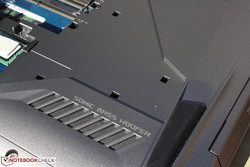
The stereo speakers are on the rear of the notebook behind the display. The large grilles become visible only after opening the lid. Since this is the thickest part of the notebook, larger speakers can be used as opposed to having smaller ones near the front. The dedicated subwoofer is located on the bottom of the unit.
Sound quality is very good with acceptable bass and great balance. Quality does not degrade on higher volume settings with no audible static. The Sonic Studio II software is easy to use and includes options to better recognize and accentuate human speech for gaming.
Battery Life
The non-removable 67 Wh battery is smaller in capacity than the one in the G751. When combined with the lack of Optimus and the supposedly higher power state of the NVMe SSD, battery life for the G752 is below average even for a gaming notebook. We were able to clock in just under 2 hours when sitting idly on the desktop on Power Saver mode and on minimum display brightness. Competing models have much longer runtimes under similar conditions.
Charging from zero to full load will take about an an hour and 45 minutes. The data in the table below is provided in minutes.
December 15, 2015 update: At Asus' request, we have reran our battery life tests with our updated results shown below. Our previous results were lower than Asus' claims and may have been due to active background activity whilst running the battery life tests.
| Asus G752VT 67 Wh | Asus G751JY 88 Wh | Eurocom P7 Pro 82 Wh | MSI GT72S 6QF 83 Wh | MSI GS70-6QE16H21 56 Wh | Asus GL771JM 56 Wh | Gigabyte P37X 76 Wh | |
|---|---|---|---|---|---|---|---|
| Battery runtime | 0% | -6% | 51% | -2% | 54% | 41% | |
| Reader / Idle (h) | 3.8 | 3.5 -8% | 2.7 -29% | 6.5 71% | 4 5% | 9.6 153% | 5.5 45% |
| WiFi v1.3 (h) | 3.1 | 2.4 -23% | 4.9 58% | 3 -3% | 4.2 35% | 4 29% | |
| Load (h) | 1.2 | 1.3 8% | 1.6 33% | 1.5 25% | 1.1 -8% | 0.9 -25% | 1.8 50% |
Pros
Cons
Verdict
ROG notebooks have always been a recommended buy for their quality hardware and active fanbase of owners. The capstone G750 series may be large and heavy, but fan noise is always very low as a result. Asus has capitalized on this advantage even further for an even quieter notebook. Surface temperatures are also remarkably low and neither the CPU nor the GPU will throttle when gaming.
Look past the cooling system, however, and the G752 isn't a huge step forward from the G751. The keyboard and touchpad are identical and the display has only been marginally improved. For better or worse, case quality has not improved from the already excellent G751, so much of the focus has been on the aesthetic side. There is no support for manual graphics switching, battery life is short, and motherboard accessibility remains out of reach.
The problem is not that the G752 is a poor gaming notebook, but that competing manufacturers are improving faster with each generation compared to Asus. The MSI GT72S offers NVMe in RAID 0, upgradeable GPU, and more storage bays wrapped in a chassis that is vastly improved over the GT70. The Eurocom Sky X9 based on the newer Clevo P870DM barebones sports desktop CPUs and Nvidia GPUs, both of which are upgradeable for longer legs. It's true that costlier vapor cooling may bring about lower fan noise and temperatures, but it may not be worth it if competing models can squeeze out more performance and features for about the same price.
If price is a concern, existing ROG owners may want to upgrade to the G751 instead. The G752 may be thinner, but users won't be missing much otherwise. For now, the GT72S and Clevo P870DM are excellent alternatives with more accessible features.
Asus G752VT
- 01/12/2016 v5 (old)
Allen Ngo


